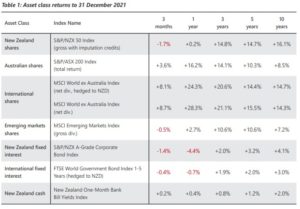Key market movements for the quarter
The quarter started on a positive note for most share markets which, aside from a November lull, mostly ended the year strongly. It was a slightly different story in bond markets, with a weak start extending to early November, and generally a small recovery thereafter.
Developed sharemarkets benefited from signs of economic resilience and good corporate earnings, leading to international developed market shares generating the best returns over the quarter. Economic growth continues to look relatively robust in spite of ongoing concerns about supply bottlenecks, rising inflation, potential central bank policy changes and the emergence of the Omicron variant of Covid-19. By comparison, the New Zealand sharemarket wasn’t as rewarding to investors, with consumer and business confidence both waning.
Overall, key interest rates were relatively unchanged internationally, although not without some intra-quarter volatility, as inflation fears and uncertainties about Omicron both impacted sentiment at times.
International shares
International developed sharemarkets generally enjoyed a strong final quarter of the year.
In the USA, the flagship S&P 500 Index (total returns in USD) shrugged off an indifferent month in November and delivered an impressive +11.0% for the quarter. By year end, investors were seemingly less concerned about the rising spread of Omicron, or the potential speed of the Federal Reserve asset tapering. Instead, investors were taking their cues from robust corporate earnings reports and a generally stable/positive economic outlook. The technology sector was one of the strongest performers over the quarter, with chipmakers especially strong. Real estate companies also performed well, as investors expect e-commerce growth to drive further demand for industrial warehousing.
European markets followed a similar pattern. While a number of countries introduced restrictions on sectors such as travel and hospitality to try and reduce the spread of the new variant, the equity markets drew support from early data indicating a lower risk of severe illness. Utilities and IT companies were amongst the top performers for the quarter along with a rebounding luxury goods sector.
The UK market also performed well with the MSCI UK Index gaining +5.2%. This was once again slightly below the average return for the region, with the MSCI Europe ex UK Index returning +7.0%. A number of defensive areas in the UK outperformed, including some of the large internationally diversified consumer staples groups. However, domestically focused areas such as UK consumer-facing retailers and housebuilders were volatile as speculation about changes in UK base interest rates picked up, and the share prices of travel and leisure companies were buffeted by the latest Omicron related restrictions.
Despite an increasingly positive outlook, Japan trailed all the major markets for the quarter, with the MSCI Japan Index declining by -0.9%. Japan’s general election was held in October (where the ruling Liberal Democratic Party was returned with a solid majority) and there was some initial uncertainty over the new Covid variant. This may have temporarily obscured the improving economic news. In particular, the strength of the rebound in industrial production as automobile output began to recover from the temporary weakness caused by the global semiconductor shortage.
While the Japanese share market regained some ground in December, it was too little too late to salvage a positive quarter.
In New Zealand dollar terms, the MSCI World ex-Australia Index delivered a quarterly return of +8.1% on a hedged
basis and +8.7% unhedged. The rolling 12 month return for the New Zealand dollar hedged index was +24.3% while
the unhedged index gained +28.3%.
Source: MSCI World ex-Australia Index (net div.)
Emerging markets shares
Emerging market shares generally underperformed developed markets. Turkey was the weakest index market amid extreme volatility in the currency. The Central Bank of Turkey lowered its overnight interest rates by 4.0% over the quarter, but this only fuelled already rampant domestic inflation which ended the year at an eye-watering 36.1%. Unsurprisingly, the Turkish Lira has been coming under significant pressure.
In other key emerging nations – Brazil underperformed as the central bank continued to hike interest rates in response to rising inflation; Russia lagged as geopolitical tensions with the West ratcheted up amid a build-up of Russian troops on the Ukraine border; and China finished in negative territory as concerns over slowing growth persisted.
In contrast, Egypt, Peru and UAE all posted double-digit gains in US Dollar terms, while Taiwan (aided by a strong performance from semiconductor manufacturers) Indonesia and Mexico all recorded solid gains and outperformed. In unhedged New Zealand dollar terms, the MSCI Emerging Markets Index produced a quarterly return of -0.5%, culminating in a +2.7% return over the last 12 months.
Source: MSCI Emerging Markets Index (gross div.)
New Zealand shares
New Zealand was one of the poorer performing global developed sharemarkets over the quarter with the S&P/NXZ 50 Index returning -1.7%, dragged down by a general underperformance from larger capitalisation companies. This concluded a relatively subdued calendar year for the New Zealand market, with the index up a mere +0.2%, one of the worst developed markets for the year after delivering in the upper echelon in recent years.
New Zealand’s economic outlook remains positive. An extremely tight labour market is providing strong job security, and third quarter GDP data released in December showed that lockdowns hadn’t damaged economic activity as much as feared. Whilst Covid-19 continues to create uncertainty, New Zealand’s high vaccination rates are considered a strong positive.
However, consumer and business confidence deteriorated in December. For households, high inflation is eroding purchasing power. There is an increasing awareness of higher interest rates in the pipeline and the growing challenge this might present to the housing market. For businesses, labour shortages, cost pressures and supply chain disruptions were also weighing on confidence.
On the local share market, winners and losers were quite evenly split amongst the top 50 companies for the quarter, although there was, as always, a wide dispersion of individual returns. An earnings upgrade saw Steel and Tube’s share price jump +50.5% over the quarter. Similarly, Sky Network Television announced significant permanent cost savings and revenue growth, which saw their share price leap in early December, closing out the quarter with a gain of +37.8%.
Meanwhile, even though Ryman Healthcare produced a solid enough profit result for the first half of the year in trying conditions for the sector, it experienced a gradual decline in share price. Ryman ended the fourth quarter -18.3% lower, effectively giving up its gains from the previous quarter.
Source: S&P/NZX 50 Index (gross with imputation credits)
Australian shares
The Australian sharemarket (ASX 200 Total Return Index) returned +2.1% quarter in local currency (returns to unhedged New Zealand investors were increased by a small appreciation in the Australian dollar over the quarter).
While all parts of the market contributed positively, it was the mid capitalisation companies (those ranked 51 to 100 in the index) which performed the strongest, gaining +5.8%. The materials and utilities sectors both produced positive double-digit results, while energy companies, information technology and, to a lesser extent financials, all struggled.
Fortescue Metals rebounded from a horror third quarter by gaining +28.4% on the back of a more than 20% rally in iron ore prices from mid November. Also aiding sentiment, was news that subsidiary Fortescue Future Industries (FFI) will become the largest supplier of green hydrogen to the United Kingdom after signing a multi-billion-pound deal.
A notable underperformer during the quarter was Magellan Financial Group which forecast a 6% decrease in its fiscal 2022 revenues, after a UK-based wealth manager ended a contract with the company. The mandate, Magellan’s largest, accounted for an estimated 12% of its revenues, and news of its departure sent Magellan’s shares to their sharpest fall on record, closing the quarter down -40.0%.
The 2021 calendar year return was a robust +16.2% in New Zealand dollars.
Source: S&P/ASX 200 Index (total return)
International fixed interest
Bond markets were buffeted over the quarter by concerns of persistent elevated inflation, hawkish central bank policy shifts and the emergence of the Omicron Covid-19 variant.
Overall, 10 year government yields were largely unchanged. Yields had been drifting downwards for most of the quarter before reversing in the final weeks of the year. Yield curves also tended to flatten in this process, with shorter-dated bonds hit harder as central bank rhetoric increasingly suggested an earlier reduction in existing financial stimulus and/or earlier action on interest rate hikes. Most notably, the US Federal Reserve (Fed) policy committee suggested in December that their tapering of asset purchases could be accelerated.
The US 10 year Treasury yield overall was little changed for the quarter, moving from 1.49% to 1.51%. However, it reached a high of 1.71% in October amid elevated inflation and expectations of policy tightening, then a low of 1.34% in early December amid fears over the Omicron Covid-19 variant. The US 2 year yield increased from 0.28% to 0.73% over the quarter.
The UK 10 year yield fell from 1.02% to 0.97%, dropping sharply in early November as the Bank of England (BoE) unexpectedly elected not to raise rates. The BoE did, however, raise rates in December. Germany’s 10 year yield was little changed, from -0.19% to -0.18%, but this reflected a late surge with the yield having fallen below -0.40% in December.
Corporate bonds lagged government bonds for the quarter. Within the investment grade bond universe, the US market saw modestly positive total returns (local currency), but Europe weakened.
The FTSE World Government Bond Index 1-5 Years (hedged to NZD) returned -0.4% for the quarter, while the broader Bloomberg Global Aggregate Bond Index (hedged to NZD) returned +0.2%. This meant a negative year for global bonds with returns of -0.7% and -1.2% respectively.
Source: FTSE World Government Bond Index 1-5 Years (hedged to NZD)
New Zealand fixed interest
At both their 6 October and 24 November meetings, the Reserve Bank of New Zealand (RBNZ) elected to increase the official cash rate by 0.25%, taking this benchmark rate from 0.25% to 0.75% over the quarter.
At their November meeting, the committee noted that global inflation had increased due to the rapid recovery in global demand, combined with significant supply chain bottlenecks and labour shortages in some sectors. Ongoing higher government spending and monetary policy stimulus in many countries was contributing to strong demand. However, there was also considerable uncertainty about the persistence of global inflationary pressures. The committee noted they expected inflation to remain high in the near term, before returning to the midpoint of their target band over the next two years.
Investors largely held with the view that the RBNZ would continue to steadily hike the official cash rate (OCR) in 0.25% increments until August 2022, before continuing with hikes at a slower pace. Over the quarter, the New Zealand 10 year government bond yield, climbed from 2.02% at the beginning of October to a peak of 2.68% on 12 November, before easing back to close the year at 2.33%, a yield increase of 0.31% over the quarter. The New Zealand 2 year government bond yield followed a similar pattern opening the quarter at 1.03% and ending the year at 1.98%, a yield
increase of 0.95%.
Similar to the effects seen overseas, this flattening of the local yield curve and rising yield environment overall, generally meant negative short term returns for bonds of all durations.
The S&P/NZX A-Grade Corporate Bond Index fell -1.4% for the quarter and -4.4% for the year, while the longer duration but higher quality S&P/NZX NZ Government Bond Index fell -1.8% for the quarter and -6.2% for the year.
Source: S&P/NZX A-Grade Corporate Bond Index

Unless otherwise specified, all returns are expressed in NZD. We assume Australian shares and emerging market shares are invested on an unhedged
basis, and therefore returns from these asset classes are susceptible to movement in the value of the NZD. Index returns are before all costs and tax.
Returns are annualised for time periods greater than one year


